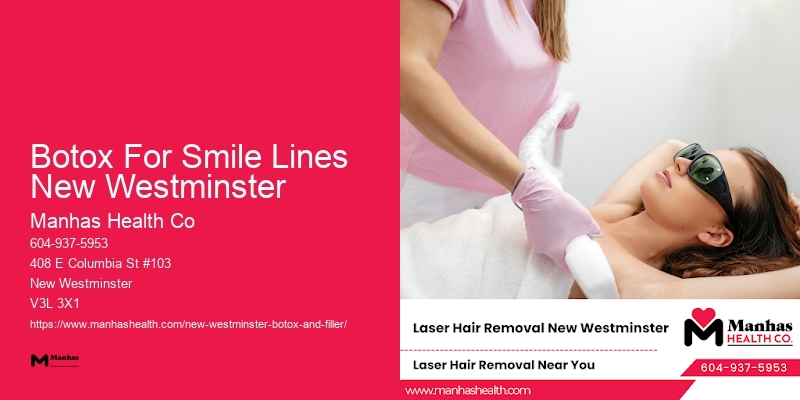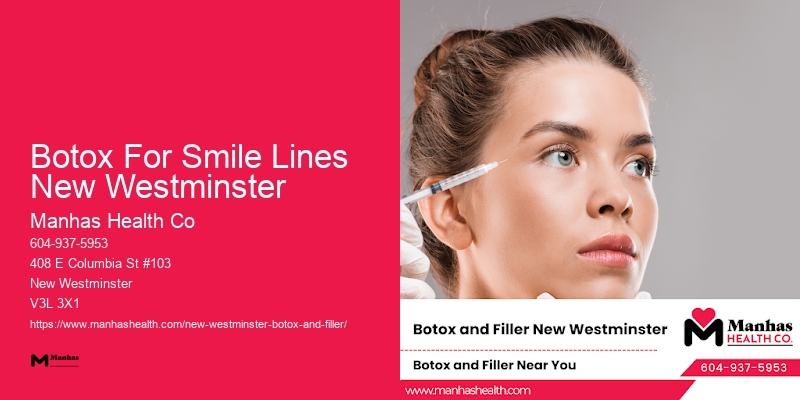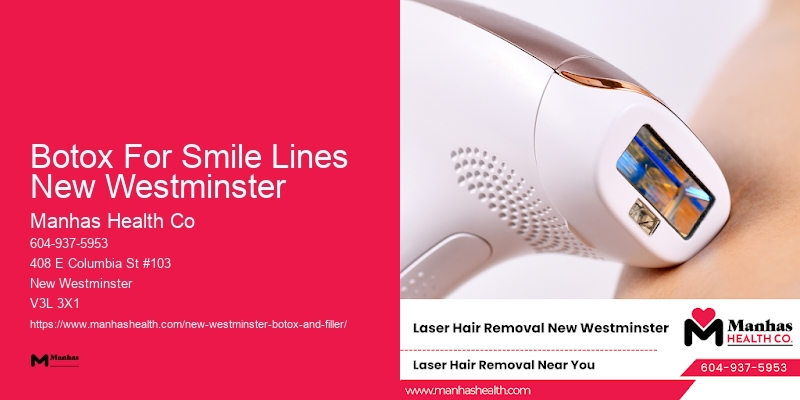

The procedure itself is quick, often completed within minutes, and requires no downtime, making it an ideal choice for our busy clients. Whether it's smile lines, marionette lines, or dimpling in the chin, Botox can help smooth these areas, enhancing your natural beauty. We're here to accommodate your schedule and answer any preliminary questions you might've about cosmetic Botox and what it can do for you.
Booking your appointment at Manhas Health Co. is the first step.
New Westminster (colloquially known as New West) is a city in the Lower Mainland region of British Columbia, Canada, and a member municipality of the Metro Vancouver Regional District. It was founded by Major-General Richard Moody as the capital of the Colony of British Columbia in 1858 and continued in that role until the Mainland and Island colonies were merged in 1866. It was the British Columbia Mainland's largest city from that year until it was passed in population by Vancouver during the first decade of the 20th century.
Choosing Botox at Manhas Health Co. Botox For Neck Rejuvenation means opting for a smoother, more refreshed look with a team committed to your care and satisfaction. Whether it's crow's feet, forehead lines, or frown lines that bother you, we've got the expertise to address those concerns. We're proud to say that every member of our team isn't just highly trained in their field, but also passionately committed to providing the best possible care and results for our clients. Our specialists have extensive experience in administering cosmetic Botox, ensuring that each treatment is tailored to meet the individual needs and expectations of our clients. To schedule your personalized Botox consultation, simply reach out to our clinic's reception.


Our team is committed to providing personalized care that aligns with your unique desires and health objectives.
We're committed to creating a welcoming and stress-free environment, so you'll feel at ease throughout the process. We've seen firsthand how these treatments can smooth out facial wrinkles, reduce lines around the eyes and forehead, and give a more rested, youthful appearance. Our team is composed of highly skilled professionals who specialize in cosmetic treatments, ensuring you're in the safest hands.


Remember, this initial consultation is your opportunity to ask questions and express any concerns you might have.
It's crucial not to rub or massage the treated areas for at least 24 hours; this prevents the Botox from spreading to unintended muscles. Learn more about Botox For Smile Lines New Westminster here That's why we focus on a natural, refreshed appearance, tailoring each treatment to your unique facial structure and aesthetic goals. Our Botox procedures typically take only about 15 to 30 minutes from start to finish. From preparing for your session to following through with aftercare, we ensure a seamless experience that promises results.
That's why we've streamlined our process, ensuring that appointments, including consultation and treatment, are efficient without compromising on quality or safety. These results last around three to four months, after which you can return for a touch-up.


A clinic (or outpatient clinic or ambulatory care clinic) is a health facility that is primarily focused on the care of outpatients. Clinics can be privately operated or publicly managed and funded. They typically cover the primary care needs of populations in local communities, in contrast to larger hospitals which offer more specialized treatments and admit inpatients for overnight stays.
Most commonly, the English word clinic refers to a general practice, run by one or more general practitioners offering small therapeutic treatments, but it can also mean a specialist clinic. Some clinics retain the name "clinic" even while growing into institutions as large as major hospitals or becoming associated with a hospital or medical school.

The word clinic derives from Ancient Greek κλίνειν klinein meaning to slope, lean or recline. Hence κλίνη klinē is a couch or bed and κλινικός klinikos is a physician who visits his patients in their beds.[1] In Latin, this became clīnicus.[2][3]
An early use of the word clinic was "one who receives baptism on a sick bed".[4]

Clinics are often associated with a general medical practice run by one or several general practitioners. Other types of clinics are run by the type of specialist associated with that type: physical therapy clinics by physiotherapists and psychology clinics by clinical psychologists, and so on for each health profession. (This can even hold true for certain services outside the medical field: for example, legal clinics are run by lawyers.)
Some clinics are operated in-house by employers, government organizations, or hospitals, and some clinical services are outsourced to private corporations which specialize in providing health services. In China, for example, owners of such clinics do not have formal medical education. There were 659,596 village clinics in China in 2011.[5]
Health care in India, China, Russia and Africa is provided to those regions' vast rural areas by mobile health clinics or roadside dispensaries, some of which integrate traditional medicine. In India these traditional clinics provide ayurvedic medicine and unani herbal medical practice. In each of these countries, traditional medicine tends to be a hereditary practice.

The function of clinics differs from country to country. For instance, a local general practice run by a single general practitioner provides primary health care and is usually run as a for-profit business by the owner, whereas a government-run specialist clinic may provide subsidized or specialized[dubious – discuss] health care.
Some clinics serve as a place for people with injuries or illnesses to be seen by a triage nurse or other health worker. In these clinics, the injury or illness may not be serious enough to require a visit to an emergency room (ER), but the person can be transferred to one if needed.
Treatment at these clinics is often less expensive than it would be at a casualty department. Also, unlike an ER these clinics are often not open on a 24/7/365 basis. They sometimes have access to diagnostic equipment such as X-ray machines, especially if the clinic is part of a larger facility. Doctors at such clinics can often refer patients to specialists if the need arises.[6]

Large outpatient clinics vary in size, but can be as large as hospitals.
Typical large outpatient clinics house general medical practitioners (GPs) such as doctors and nurses to provide ambulatory care and some acute care services but lack the major surgical and pre- and post-operative care facilities commonly associated with hospitals.

Besides GPs, if a clinic is a polyclinic, it can house outpatient departments of some medical specialties, such as gynecology, dermatology, ophthalmology, otolaryngology, neurology, pulmonology, cardiology, and endocrinology. In some university cities, polyclinics contain outpatient departments for the entire teaching hospital in one building.

Large outpatient clinics are a common type of healthcare facility in many countries, including France, Germany (long tradition), Switzerland, and most of the countries of Central and Eastern Europe (often using a mixed Soviet-German model), as well as in former Soviet republics such as Russia and Ukraine;[7] and in many countries across Asia and Africa.[8]
In Europe, especially in the Central and Eastern Europe, bigger outpatient health centers, commonly in cities and towns, are called policlinics (derived from the word polis, not from poly-).
Recent[when?] Russian governments have attempted to replace the policlinic model introduced during Soviet times with a more western model. However, this has failed.[9]
In the Czech Republic, many policlinics were privatized or leasehold and decentralized in the post-communist era: some of them are just lessors and coordinators of a healthcare provided by private doctor's offices in the policlinic building.[10]
India has also set up huge numbers of polyclinics for former defense personnel. The network envisages 426 polyclinics in 343 districts of the country which will benefit about 33 lakh (3.3 million) ex-servicemen residing in remote and far-flung areas.[11]
Policlinics are also the backbone of Cuba's primary care system and have been credited with a role in improving that nation's health indicators.[12]


Providing health services through mobile clinics provides accessible healthcare services to these remote areas that have yet to make their way in the politicized space. For example, mobile clinics have proved helpful in dealing with new settlement patterns in Costa Rica. Before foreign aid organizations or the state government became involved in healthcare, Costa Rica's people managed their own health maintenance and protection.[13] People relied on various socio-cultural adaptations and remedies to prevent illnesses, such as personal hygiene and settlement patterns.[13] When new settlements that sprang up along the coast became "artificial" communities, and due to lack of traditional home healing practices here, alternative methods such as mobile clinics had to be implemented in these communities for the protection and prevention of diseases.[13]
A study done in rural Namibia revealed the health changes of orphans, vulnerable children and non-vulnerable children (OVC) visiting a mobile clinic where health facilities are far from the remote villages.[14] Over 6 months, information on immunization status, diagnosis of anemia, skin and intestinal disorders, nutrition, dental disorders was collected and showed that visits to mobile clinics improved the overall health of children that visited regularly. It concluded that specified "planning of these programs in areas with similarly identified barriers may help correct the health disparities among Namibian OVC and could be a first step in improving child morbidity and mortality in difficult-to-reach rural areas."[14]

Food supplementation in the context of routine mobile clinic visits also shows to have improved the nutritional status of children, and it needs further exploration as a way to reduce childhood malnutrition in resource-scarce areas. A cross-sectional study focussed on comparing acute and chronic undernutrition rates prior to and after a food-supplementation program as an adjunct to routine health care for children of migrant workers residing in rural communities in the Dominican Republic.[15] Rates of chronic undernutrition decreased from 33% to 18% after the initiation of the food-supplementation program and shows that the community members attending the mobile clinics are not just passively receiving the information but are incorporating it and helping keep their children nourished.[15]

There are many different types of clinics providing outpatient services. Such clinics may be public (government-funded) or private medical practices.
{{cite book}}: |website= ignored (help)
Cosmetic may refer to:
This article needs additional citations for verification. (March 2012) |

A facial is a family of skin care treatments for the face, including steam, exfoliation (physical and chemical), extraction, creams, lotions, facial masks, peels, and massage. They are normally performed in beauty salons, but are also a common spa treatment. They are used for general skin health as well as for specific skin conditions. Types of facials include European facial,[1] LED light therapy facials, hydrafacials and mini-facials.
There are different kinds of masks (e.g., clay, cactus, cucumber) for different purposes: deep-cleansing, by penetrating the pores; healing acne scars or hyper-pigmentation; brightening, for a gradual illumination of the skin tone. Facial masks also help with anti-aging, acne, crows feet, under eye bags, sagging lids, dark circles, puffiness,[2] and more. Some masks are designed to dry or solidify on the face, almost like plaster; others just remain wet. The green face mask is very essential and benefited.
Masks are removed by either rinsing the face with water, wiping off with a damp cloth, or peeling off of the face. Duration for wearing a mask varies with the type of mask, and manufacturer's usage instructions. The time can range from a few minutes to overnight. Those with sensitive skin are advised to first test out the mask on a small portion of the skin, in order to check for any irritations. Some facial masks are not suited to frequent use. A glycolic mask should not be used more frequently than once a month to avoid the risk of burning the skin.
Masks can be found anywhere from drugstores to department stores and can vary in consistency and form. Setting masks include: clay, which is a thicker consistency, and will draw out impurities (and sometimes, natural oils, too) from the pores; a cream, which stays damp to hydrate the skin; sheet-style, in which a paper mask is dampened with liquid to tone and moisturize the skin; and lastly, a hybrid/clay and cream form that includes small beads for removing dead surface skin cells. Non-setting facial masks include warm oil and paraffin wax masks. These different forms are made to suit different skin types (e.g., oily or dry), and different skincare goals or needs (e.g., moisturizing, cleansing, exfoliating). Clay and mud masks suit oily and some "combination" skin types,[3] while cream-based masks tend to suit dry and sensitive skin types. There are also peel-off masks which are used to remove thin layers of dead skin cells and dirt.[4]
I found this place on Instagram and I decided to ask for laser hair removal… I sent them a message and they booked me a session. When I arrived Ana was at the front desk, she was super lovely and happy to help( she also booked me my other 5 laser session for a very good price 😻) Dyana was my beautician, she is very sweet and careful with the technic, the session was very fast and efficient, I could see the result just right after, I was very impressed. I’m very happy with the service you provide and you deserve the good reviews so here we are! Thank you all the staff 💯⭐️
The place to go for all your aesthetic needs. I've had AMAZING results with laser hair removal! Nasim and Julia have both been incredible, providing comfort, friendliness and most important the results your looking for!
An exceptional facial experience! The skilled esthetician personalized every step to my skin's needs, leaving me glowing and refreshed. The products used were of the highest quality, and the attention to detail was remarkable. I left feeling pampered and revitalized. Definitely five stars for this facial!
I recently had a great experience at Manhas. Julia has been incredibly helpful and thorough throughout the entire process. She took the time to answer all my questions and made me feel comfortable every step of the way. My first session was great with her. She walks you through every step and makes it a very comfortable experience. The atmosphere is welcoming, and the staff is professional. I highly recommend this place for anyone considering laser hair removal!
I recently had an excellent experience with Julia, a highly professional and knowledgeable laser technician, from the moment I arrived at the reception. The staff was welcoming and efficient, setting a great tone for the visit. Julia made the entire process comfortable by thoroughly explaining the procedure and addressing all of my concerns. Her attention to detail, focus on hygiene, and personalized approach left me feeling confident in her care. Julia’s calm and friendly demeanor, combined with her expertise, resulted in fantastic treatment outcomes that exceeded my expectations. I highly recommend her and the entire team!
We've established a comprehensive approach to manage any potential side effects from Botox treatments, ensuring our clients receive prompt follow-up care. Our protocol includes immediate assessment and tailored support to address each individual's needs.
We're wondering if there are unique Botox formulations offered exclusively by this provider that you can't find anywhere else. It's intriguing to think about the potential benefits of such proprietary treatments in enhancing beauty.
We're curious about how the body breaks down cosmetic botox and whether it affects skin health or muscle function in the long run. It's crucial to understand these implications to make informed decisions about treatments.